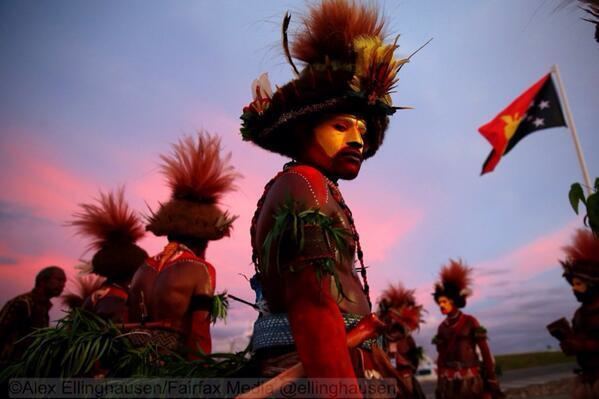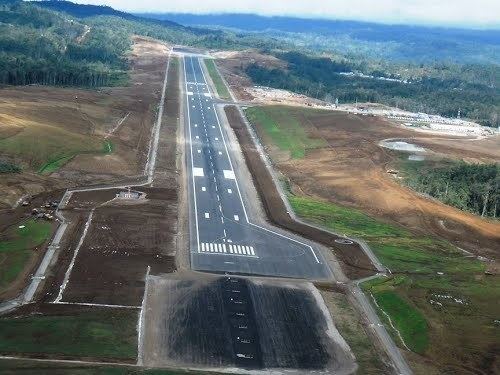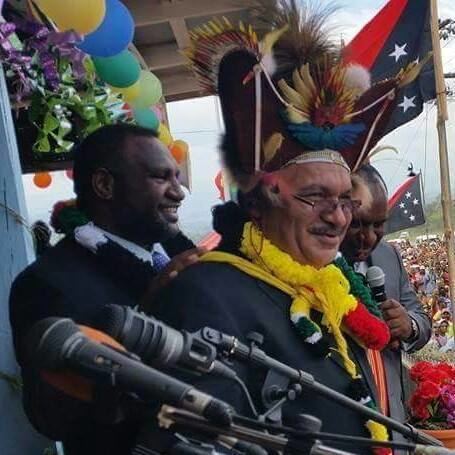Time zone AEST (UTC+10) Founded 2012 | Formation 2012 Area 10,498 km² | |
 | ||
Districts ListKomo-Magarima DistrictKoroba-Kopiago DistrictTari-Pori District | ||
Puya wane daniel huri
Hela is a province of Papua New Guinea. The provincial capital is Tari. The province covers an area of 10,498 km², and there are 249,449 inhabitants (2011 census figures). Hela province officially came into being on 17 May 2012, comprising three districts previously part of Southern Highlands Province.
Contents
- Puya wane daniel huri
- Districts and LLGs
- Historical Establishment
- Huli
- Opene
- Duna
- Tuguba
- Hewa
- Damian Arabagali
- Handape Tiahape
- Sir Andrew Wabiria
- Sir Matiable Yuwi
- HonAlfred Aluago Kaiabe
- Aruru Matiabe
- Albert Mokai
- Hela Wigmen RLC
- Hekari FC
- Cosmology and Idea of Hela Province
- Members of the National Parliament
- References

Districts and LLGs

There are three districts in the province. Each district has one or more Local Level Government (LLG) areas. For census purposes, the LLG areas are subdivided into wards and those into census units.
Historical Establishment

Hela Province has been an established politically in recent years but the notion of an independent province has been in the hearts of the ethnic Huli people who are the largest single Ethnic group in Papua New Guinea numbering up to over half a million in population. Recent estimates put them at 7-800,000. Oral History suggests that the grand Ancestor of the Huli was a man named Hela who had 4 sons and a daughter from which the Hela nation was to emerge. The offsprings of Hela were sons Huli, Opene, Duna, Tuguba and sister Hewa. Traditional Hela Territory ranged from whole of Enga Province (Opene) (Mt Porgera specifically Kumbi Para, ipa Yambale where sacrifice to traditional gods took place) to Mt Tundaka (Sacrificial sacred area) to Lake Kutubu to Mt Bosavi to Mt Gigira to the Strickland gorges bordering western and West/East Sepik Provinces.
Territories and resources given as birthright to each by Hela are as follows.
Huli

The designated land area of huli include Tari pori, margarima,Komo,benaria, hulia and Tani, south Koroba areas and part of North Koroba. Under this area is Mt Kare gold project, Moran and Moro Oilfields=.Moro oilfields are in Southern Highlands Province
Opene

Opena land includes whole of current Enga Province. Opene was the first born son of Hela and under its boundary was given the largest gold mine in PNG, Porgera.
Duna
Duna Land includes the whole of strickland gorge,part of North Koroba LLG, and all Kopiago Basin, Awi-Pori.
Tuguba
Tuguba lands start from Mt Bosavi and ends at Mt Gigira. traditionally tuguba lands was known as any areas opposite the Tagali river from Huli lands. Under its lands lies the Hides, Juha and Mananda petroleum projects.
Hewa
Hewa lands are found in the Lake Kopiago Rural district. This includes the lands bordering both the Laigaip and Om Rivers as well as the headwaters of the Strickland River and the grasslands of the Strickland gorge north of the Duna lands around the Galaga settlement.
Damian Arabagali
As of 2015 chairman of Hela Gimbu association; author of 'god dadagaliwabe was working in Hela'.
Handape Tiahape
Pioneer Member of Parliament from Hela who had to have a Huli Translator in Parliament due to lack of English/pidgin.
Sir Andrew Wabiria
The pioneer member for Kutubu, Komo Koroba, representing the area in the House of Assembly from 1964-1977. He was then Minister for Mines, Lands and Surveying. When he was minister he established the PNG chamber of Mines & Petroleum. The Papuan highly spokes person not to get Independence, which he fought hard with New Guinea leaders. He also raised the Hela District agendas together with late Sir Teii Abal Wabag MP. The Hela District bill was passed but he lost the Koroba Lake Kopiago open site in 1977. Nobody pushed through the agenda but the only Hela son Lawyer by Profession Alfred Aluago Kaiabe was elected Komo Margarima Open in 1992 and recall Late Sir Andrew wabiria OBE and Dimien Arabagali,Habia Babe,Mathew Hape,,,,,,,,,,,,,,,,,,,,,,,etc began the battle for separation of Hela Province after 38 years we received the Hela Province.
The founding Prime minister Sir Micheal Thomas Somare and he's National Alliance Party together support Jiwaka and declare twin Provinces in Papua New Guinea in 2012. Sir Late Andrew Wabiria OBE also involved in negotiation with BP company in hides,Southern Highlands Provincial Government,Enga Provincial Government ,Hides PDL1 for the Gas to Electricity to Porgera Gold Mine, he himself comes from Nogoli pajapa where his mother comes from,the Nineth (9) Tukupa tribesmen call "YUKU".
Sir Matiable Yuwi
Pioneer MP and one of the founding fathers of Papua New Guinea. Was a member of the committee overseeing the creation of the PNG constitution with the likes of Sir Michael Somare.
Hon.Alfred Aluago Kaiabe
Former member for Komo Margarima and strong fighter for a separate Hela Province.
Aruru Matiabe
Former MP for Koroba-Kopiago.
Albert Mokai
Former Premier of the Southern Highlands; from Pureni in Koroba Lake Kopiago electorate.
Hela Wigmen RLC
Hela Wigmen Rugby League Club is a Papua New Guinea semi-professional rugby league football club based in Mendi, Southern Highlands Province of Papua New Guinea. Hela Wigmen entered Papua New Guinea Semi-professional League in 2009.
Hela Wigmen represents the people of Hela Province. Because of limitations in logistics and facilities in Tari, the team is based in Mendi. Hela Wigmen is sponsored by Kemele Construction and Hides Gas Development Company (HGDC).
In 2014 they won the top national Rugby league competition, Digicel Cup in the Grand Final against Agmark Gurias in Lae Rugby League Grounds.
Hekari FC
Hekari United is a semi-professional association football club, based in Port Moresby, Papua New Guinea. The Club is owned by a Hela Businessman from Kutubu, Mr John Kapi Natto. Hekari has been sponsored by Petroleum Resource Kutubu. The team represents Kutubu but is based in the nation's capital and is composed of the best players from PNG and the Pacific.
They were winners of the 2006 (when named PRK Souths United)[1] and the 2007/2008 Papua New Guinea National Soccer League.[2]
In 2010 Hekari United became the first club to qualify for the FIFA Club World Cup UAE 2010 to be hosted in Abu Dhabi from 8–18 December.
The qualification of Hekari United is historic and represents the first time Papua New Guinea and for that matter any South Pacific Island club not from Australia and New Zealand has been involved in a FIFA club football tournament at any level.
Cosmology and Idea of Hela Province
The peoples occupying the western end of SHP, namely the Duna, Huli, tuguba, hewa, Bogaia, along with their Opene neighbours and whole of enga province, share the view that they descend from a common ancestor, known as Hela (Haley 2002b). Accordingly, they often refer to each other as brothers (Glasse 1965:33; Biersack 1995:14-16), considering themselves sons of the same father. On the basis of this connection there have been calls for many years for the formation of a Hela province, which would take in the resource-rich districts occupied by the Duna, Huli and Paiela, namely the Komo-Margarima, Tari-Pori, Koroba-Lake Kopiago, Nipa-Kutubu and Porgera-Lagaip districts (Vail 1995:360; Haley 2002b).[3] The project is for the most part Huli owned and driven, and lacks wider support, although it does have the support of many key political figures. What local-level support it has derives directly from discontent over the lack of services in the western end of the province and the lack of benefits accruing from present resource developments. It is this same discontent which led to the formation of the United Resources Party by Anderson Agiru.
These peoples also hold that the world is bound up in a process of loss, degradation and decline. This is expressed in the way they engage with their environment and in the ways they perceive and interpret environmental and social changes. Ethnographers of the Duna and Huli have repeatedly commented on this all-pervading theme (Frankel 1986; Goldman 1983; Ballard C. 1995; Strathern 1991; Stürzenhofecker 1993; Haley 2002b), which is common to the region more generally (see also Jorgensen 1981, 1985; Poole 1986; Biersack 1991, 1995). Myths found amongst these groups reveal a common belief that the world originally consisted of formless clay-like mud which was given shape and strengthened by ancestral spirits; that the cardinal elements of the universe were born of an original ancestress; and that the landscape as fashioned by the ancestors is held securely in place by a subterranean cane or cane-like python known as the ‘root of the earth’. These myths also reveal that the way of the world is such that the fertile substance, which sustains the universe, by nature dissipates, and that the expenditure of this substance will bring about the world’s end.
The peoples living in the western end of SHP similarly share the belief that they are part of a regional system deeply rooted in mythology and ritual, and that the fertility of their region is morally constituted. This means they must act and behave in certain ways for their world to be fertile. Such was the basis of their pre-colonial cosmologies. Indeed, in the past, Duna, Huli, Hewa, Bogaia and Paiela participated collaboratively in ground-seeding and ground-making rituals which sought to ensure the ongoing fertility of the region (Haley 2002b). These rituals, which involved the sacrifice of human substances and body parts in order to replenish the root of the earth, were enacted along ritual ‘roads’ which criss-crossed the region.
Specifically, there were at least five major ritual roads crossing the Duna region, these being Kirau atia, Ambua atia, Hewari atia, Nona atia and Miliano atia, and another, Ukuam Sama, traversing the Bogaia region. One thing these roads had in common is that they all terminated outside the Duna area. The most southerly road, Kirau atia, started in Bogaia country near Bulago and proceeded via Nogoli to Gelogili in Huli country (Gelote in the Huli literature. See Goldman 1979; Ballard C. 1995). Ambua atia started on the Oksapmin side of the Strickland Gorge and, it seems, originally terminated at Bebenite, south of Tari.[4] The third road, Hewari atia, commenced at the Duna parish of Angora in the mid Pori River area and travelled through the Logaiyu and Urei river valleys into the Ipili-speaking areas and thence to Mt Kare where it terminated. Nona atia commenced in the Strickland Gorge on Yokona ground, traversed the south Hewa area, and likewise terminates at Mt Kare. The final road, Miliano atia, commenced in Hewa country, traversed Duna country from north to south, and terminated in the Bogaia area. Ritual sites linked by these roads typically featured ground oil seeps and natural gas seeps, which became the focus of the rituals which sought to replenish fertile substance in order to restore and ensure the ongoing fertility of the region.
Even today, despite the almost complete absence of indigenous ritual practice, Duna hold to the belief that moral behaviour conserves fertile substance, and that immoral behaviour sees it depleted and will ultimately bring about the world’s end. Ongoing fertility continues to be something Duna must negotiate through appropriate moral behaviour and proper social intercourse (Haley 2002b). Indeed, it is their actions which render specific substances, particularly (but not exclusively) fluid substances, either inimical to growth or capable of inducing fertility. Linked to this is the notion that inappropriate moral behaviour can render a previously fertile substance infertile (see also Ballard C. 2000:210). Mineral resources are seen as examples of fertile substance which originate from deep within the root of the earth. As such they must be properly handled and engaged with in a morally appropriate manner. Duna hold that social intercourse in relation to mineral extraction must also be properly managed, and that the flow of resources elsewhere must be curtailed, lest the fertile substance sustaining the world be depleted at a rate which brings about the end of the world.
How is this relevant to a discussion of politics? For generations, Duna, Huli and Paiela and their more immediate neighbours performed cooperative rituals aimed at re-making and re-fashioning the ground so as to ensure the ongoing fertility of the entire region. Specifically, these involved replenishing the earth’s fertile core. In the contemporary context, Duna claim the Huli and Paiela have forgotten this. They cite their exclusion from Mt Kare as a case in point. Indeed, although many Duna clans in the upper Pori area directly descend from Ko-Yundikia (the spirit associated with Mt Kare) and several old men from these groups had sacrificed pork to Ko-Yundikia in their own lifetimes, Duna were chased away from Mt Kare during the height of the gold rush. Duna feel that their Huli and Paiela ‘brothers’ should have recognised and acknowledged their claims, especially as they had been cooperatively responsible for Ko-Yundikia’s ritual propitiation for generations. Furthermore, Duna maintain that they continued observances at Mt Kare well into the early 1970s, long after the Huli had abandoned these practices.[5]
Duna, today, charge the Huli, in particular, with having forsaken both the regional ritual projects which they once strongly promoted (Ballard C. 1994; 2000:213) and the ties which made such cooperative performances possible. Instead of being concerned to preserve the fertile substance of the earth’s core, Duna see the Huli and Ipili as pillaging it. They regard the gold, oil and gas being extracted at Porgera, Mt Kare, Nogoli, Moran, Kutubu and Gobe as examples of this fertile substance, and insist that the Huli are wantonly consuming fertile substance which should be conserved so as to sustain them and the world.
This blood taken along Kirau atia and Ambua atia was fertiliser for gardens, medicine for pigs and children. Those things started here. But where they stored them, that was at Nogoli [Hides Gas], on the Huli side. They have forgotten the true origins of Kirau atia and Ambua atia. We believe that there is something important here — mineral oil, gas or something. We don’t know. Our ancestors told us not to dig the ground in the [Strickland] Gorge. They said, if we did, this thing would come out and burn us all … Where those roads ended they are extracting gas. We too are responsible for that gas. Those things started here. (Andrew Makano 1997; Robinson Fieldnotes Notebook 4:129-130).
In the contemporary context, Duna feel that Huli have sold them out. They charge the Huli with monopolising for themselves the fruits born of their cooperative ritual efforts.
The boy went that way and the girl went this way. She went with a female pig. That pig didn’t take a walk by itself. The people here took it up that way. They would call the name of each group. One group would bring it and give it to the next, all the way to Gelogili … Before we [Huli and Duna] stayed together like a married couple. Our union bore fruit. Our union bore the oil and gas … Those things are as much ours. But they [the Huli] are using it, expending it. They have forgotten us (Sane Noma 1994; Haley Fieldnotes Notebook 3:48; 54).
The Duna likewise charge the Huli with having forgotten that they are brothers who trace descent from a common ancestor, Hela. Almost without exception, Duna now preface conversations and statements about mining and other large-scale development projects with statements to the effect that the Duna, Ipili and Huli are brothers — Hela ingini — sons of the same father. Such appeals to common descent also form the basis of an anti-Huli sentiment which now permeates all aspects of Duna discourse.
Despite espousing the rhetoric of Duna, Huli and Paiela as brothers, Duna have not embraced the growing calls for a Hela province (Biersack 1995; Vail 1995; Goldman n.d.). They vehemently oppose such a project, seeing it as a Huli owned and driven project which will bring them no benefits (cf. Goldman n.d.:12). Some even view the calls for the formation of a Hela province as sinister in intent, fearing that if the province comes to pass they will lose both their land and their identity (Haley 2002b).
Members of the National Parliament
The province and each district is represented by a Member of the National Parliament. There is one provincial electorate and each district is an open electorate. The following table lists Members before and after the 2007 general election.
